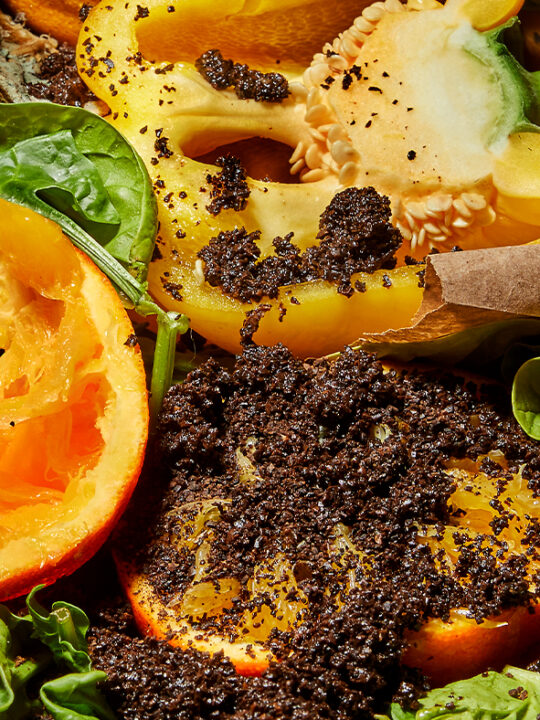
Methane.
It’s more potent of a greenhouse warming gas than Carbon Dioxide (CO2) and it’s what I focus on in my work.
But let’s dig in deeper. What is it? Why should we be concerned about it? And let’s talk about how it’s so much more than just cow farts.
What is methane?
Methane is a greenhouse gas (warming gas) found in the atmosphere.
Why is methane worse than carbon dioxide?
Methane quite literally, packs heat. Compared to other greenhouse gases, like carbon dioxide and water vapor, methane is 28 times more effective at trapping heat over a 100 year time frame, which makes it anywhere from 25-100 times more destructive than CO2 over a couple of decades. And because of its effectiveness at trapping heat, scientists attribute methane for causing 23% of recent global warming.
Why is this so bad? Because scientists estimate that we have under 12 years to combat catastrophic climate change. Since methane is such a major and powerful driver of climate change, I like to focus on ways to reduce it ranging from the individual to large culprits: landfills (hence my zero waste lifestyle), animal agriculture, and the oil and gas industry.
Concentrations of methane are…you guessed it, increasing.
And this is BAD, like really, really bad, for global warming. Since the Industrial Revolution, atmospheric concentrations of methane have more than doubled, and over the last two decades alone, global emissions of methane have risen by nearly 10 percent—which is an increase of roughly 50 million tons.

Human activity accounts for roughly 60% of total global methane emissions. So let’s dig into these top 3 sources of anthropic emissions.
Common Sources of Methane Emissions
https://www.tift-admin.com/wp-content/uploads/2020/09/TIFTEditorial_Listicle_M1.jpg
Landfills
As explained in
this article, when biodegradable materials like paper, banana peels, avocado pits, apple cores, and other food waste and scraps are thrown away into the trash, they are unable to break down in the way that nature had intended. Rather than decaying back into the soil, when organic matter is tightly squished under piles and piles of compressed trash, they are forced to decompose anaerobically (
aka without the presence of oxygen). When this happens, methane is created as a byproduct.
By the Numbers: Landfills are the
third largest source of human-related methane in the United States, accounting for just over
15% of total U.S. methane emissions. Level of individual ability to combat:
high. Why? Through daily choices, individual waste can be reduced. Composting is a top way to reduce waste to landfills and thus reduce methane. Other ways? Connect with friends, family, and community members to inspire them to reduce waste by sharing this article. Additionally, individuals can work with policy members to create policy to focus on reducing waste such as city-wide composting.
Check out this post on why voting is so important for the environment.
Shop Compost Bins
https://packagefreeshop.com/products/stainless-steel-compost-bin
https://www.tift-admin.com/wp-content/uploads/2020/09/TIFTEditorial_Listicle_M3.jpg
Extracting Fossil Fuels
The extraction of fossil fuels is another leading contributor to methane emissions, with natural gas (
38% of the total U.S. energy sector) as the leader. The process of extracting natural gas from miles beneath Earth’s surface usually involves hydraulic fracturing (
aka fracking
aka the worst thing EVER), which requires drilling down into shale rock and then forcing water, sand, and a cocktail of hundreds of different chemicals (many of which are toxic to humans and the environment!) at extremely high pressure. This mixture and pressure cause the rock to break, which releases trapped natural gas. The gas is then flowed up to the surface by wells and then sent off to a natural gas processing plant to be converted into usable energy. The problem is, methane is the
largest component of natural gas and it is commonly
(and I mean far. too. commonly.) leaked into the atmosphere during the
production, processing, storage, transmission, and distribution process of fracking and collecting natural gas. If you want to learn more,
check out Gasland by my friend Josh Fox.
Natural gas is also found with crude oil, and
methane is trapped in coal deposits, so the collection and combustion of oil, as well as the mining for coal, also contribute to increased methane emissions.
By the Numbers: Worldwide, the energy sector contributes to roughly
25% of annual methane emissions—which equals 108 million tonnes of methane being released into the atmosphere annually. Level of individual ability to combat:
low/medium. What energy your household uses is very difficult to control unless you are building a home from scratch or have the ability to install solar or geothermal. If you live in a city, like me, you are pretty dependent on the grid. While there are options to “switch to a reusable energy provider”, this option doesn’t mean your building magically receives renewable energy, it just subsidizes the production of more sustainable energy sources. If you have the ability to do this, I suggest it, but if not, the next best thing is to VOTE for politicians that want to move away from big oil and antiquated energy sources and towards natural, renewable energy. Again,
check out this post on why voting is so important for the environment.
Guide to Voting
https://trashisfortossers.com/guide-to-voting-why-it-matters-for-the-environment/
https://www.tift-admin.com/wp-content/uploads/2020/09/TIFTEditorial_Listicle_M2.jpg
Animal Agriculture
In the United States,
42 percent of agricultural emissions come from animal agriculture. Whenever livestock, including cows, buffalo, sheep, goats, and camels, digest food, methane is produced as a by-product of the digestion process and is repelled every time the animal breathes, burps or you guessed it, farts. Studies show that a single cow can produce anywhere from
250 and 500 liters, or about 66 to 132 gallons, of methane a day. To put that number into perspective, the average U.S. car only holds about 16 gallons of gas.
By the Numbers: Livestock currently accounts for
40% of annual methane emissions, and that number will only continue to rise as demand for beef and dairy grows. Level of individual ability to combat:
medium. While choosing to eat or not eat meat sounds simple, in some places, it is the only source of protein and food that people have and in some instances, dietary restrictions make it difficult to make the switch. If you do have the ability to choose your protein source and have flexibility in your diet, not eating meat or reducing the amount of meat you consume is an incredible way to reduce methane emissions and combat climate change.
Zero Waste Veggie Burgers
https://trashisfortossers.com/zero-waste-veggie-burgers/
Individual Solutions to Reduce Your Methane Emissions Today
- Compost. Composting is one of the best things that we can do for the planet. It keeps out unnecessary organic waste from landfills and reduces overall greenhouse gas emissions. Learn how to compost during quarantine here, or check out this article for a full breakdown of how it works.
4760608931937
- Reduce plastics. Reducing your trash will most likely also mean reducing your consumption of plastic, which is usually made from petroleum (aka fossil fuels). For simple ways to reduce your plastic consumption today, check out this article.
- Reducing our dependence on fossil fuels. As individuals, we can reduce our dependence on fossil fuels by choosing to walk or bike whenever possible, using public transportation, and avoiding items made of plastic.
Plastic Free Alternatives
1304277745733
11403525588
4712744517729
11403498964
4429560578145
3883470913633
11403498900
1733284757573
1792676659269
1737604104261
11403493204
4589547618401
29188030484
4693188083809
11631438932
1555853869125
4308897890401
4517348343905
1431006052421
1995386519649
11403509908
4716695388257
2112163676257
- Limit the consumption of animal products. Research shows that eating a plant based diet helps produce 50% less carbon dioxide, uses 1/11th oil, 1/13th water, and 1/18th land compared to a meat-lovers diet. Even a small reduction is good and plants can be super delicious (Don’t believe me? Check out my Zero Waste veggie burger recipe here!)
- VOTE, VOTE, VOTE! Advocate for divesting away from fossil fuels. We need leaders at the local, state, and national levels who will prioritize a shift towards a cleaner, greener energy sector. For a rundown on how voting works, check out my cheat sheet here!









